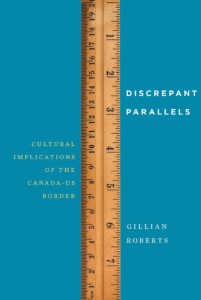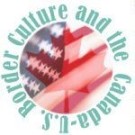by Kelly Hewson
“The border is not, then, simply an indisputable physical feature. Like the border of nations, it may appear fixed, but as a physical manifestation of complex social practices and conventions it is always susceptible to alteration and renegotiation.” (Brown and Duguid, “Borderline Issues: Social and Material aspects of Design,” 1994)
In the article from which this excerpt is taken, Brown and Duguid are writing about information technology design. They use the terms centre, periphery and border, but not in the way that economists or sociologists or political scientists might. Rather, all elements are contingent upon the given situation of use, all of which fluctuate interdependently based on the circumstances of the user and her task. The centre, to simplify, is the definitive information; the periphery is that information which is excluded from the centre; the border is the meeting of these two. The inclusion and exclusion that determine centre and periphery depend on the social practices of the community.
This summary abbreviates the depth and range of Brown and Duguid’s work, but it highlights, I hope, the elegance and flexibility of their model, a model which allows for a slight retrofit wherein I can explain 1) the kind of research Lee Easton and I have been undertaking; 2) the particular pedagogical activities such research has elicited; and 3) some possible ways to ‘teach’ the protean Canada-US border.
Allow me to demonstrate what an application of my version of Brown and Duguid’s design yields:
Let us say Lee and I want to understand how students view the Canada-US border in Guy Maddin’s film, The Saddest Music in the World. The ‘users’ would be the 30 to 35 students (in some of their diversity—as a way to access their viewing habits and to avoid the monolith of The Student, we hand out questionnaires in which students can choose or not to self-identify according to class, gender, sexuality as well as by discipline, stage of career) who constitute a first-year class. Their definitive task, or the centre, would be responding to the border question. Peripheral to that would be what viewers are including and excluding in their viewing responses. (As Brown and Duguid proffer, the theoretical divide between centre and periphery is never precise). What we have done in previous research projects– once we’ve received the written and transcribed the verbal responses to the film– is discourse analysis: we identify patterns of presences and absences in said responses, thereby provisionally categorising a series of conventions about what students render central/visible as well, and often more significantly, what is peripheral/barely or in/visible.
The act of teaching enters the scenario by creating the platform, so to speak, for meanings about the border in the film to develop. The activities of teaching also create borders, borders which limit certain meanings to encourage others. What our engagement with the Canada-US border in film studies has taught us – and what Lee’s recent theoretical work elaborates more fully — is that there are some commonly reproduced practices for viewing it. (Brown and Duguid refer to the set of conventions that travel with an artefact as a ‘‘portable context”). We can expect to hear and see among the following:
- the border as physical feature only, hence, as settled, neutral and pretty much on the periphery
- the border as symbol – part material, part social
- the border as opportunity for a narrative experience or affective response
- the border as psychic mechanism, deflecting, denying, displacing, disavowing
- the border as identity marker, separating what constitutes Canada/Canadianness from what constitutes America/Americanness
Depending on what it is we’d like the students to ‘see’ when we ask them to view the Canada-US border, we can orchestrate activities designed to bring to the fore any assumptions, digressive manuevres, blinds spots, and/or inaccuracies about the specifically represented border. Always to our surprise, though, these activities end up doing much more than remediating not-quite-there responses; oft-times the creative, critically astute outcomes surprise us out of our ‘expert’ teacher-selves. For instance, as Lee’s conference paper demonstrated, asking students to resituate an American film in a Canadian context (in this case, D.W. Griffiths’ Birth of a Nation) has proven a particularly fruitful exercise. Similarly, our development of a gap analysis project, and the results of it, overwhelmingly demonstrated to us that the “gap” the majority of students in each of our classes analysed in Canadian cinema is a fictional treatment of settler (not always white) violence towards indigenous peoples. After identifying the gap, they were to develop a film pitch to address it. Some of our classes’ pitches included a film noir treatment involving missing aboriginal women and a negligent police force; a hockey/drug film in which Team Alliance from the north of America (variously racialized and gendered) “face off” against Team Americas (comprised of white and brown gang members); a disaster film contrasting the flood relief efforts in an affluent white neighbourhood versus a first nations community; and a “happily ever after” film in which an aboriginal child is reunited with her birth mother at the behest of her adoptive white mother.
What teaching the border in a first-year film studies course teaches us is there is a growing awareness of settler borders and how they continue to disappear and disadvantage indigenous peoples. The majority of our diverse student bodies are recognising that the story they’ve been taught, told and believed about Canada is incomplete, if not fraudulent, and their mini-productions were presented as earnest attempts at filmic redress.
What teaching the border in a 4000 level class English class on Culture and the Canada-US Border (which I led in Fall 2014) teaches us is settler students’ awareness of their complicity in the structures of settler colonialism accompanied by a desire to act on that knowledge. While I have not had the chance to analyse fully the student responses from this course, Lee can attest to my sense that much of my pedagogical efforts were expended on what I’d call border patrol: creating verbal boundaries around the strong, impassioned but problematically borderless affects repeatedly infusing our community of practice. The heavy investments in Canadian multiculturalism we’ve noticed in students in previous projects emerged here, one of the results of which was too quick and frequent a move to subsume difference AND resume control, typically by re-authoring new narratives, featuring themes of recognition of settler wrongs and conciliatory, reparative gestures to start anew. The idea that no matter how empathetic we, settler allies, might be, there are some borders that we cannot cross, and those we may be invited to must be crossed in meaningful, unexploitative ways is difficult knowledge for those of us used to dictating the terms of engagement, nay, the terms of ‘civilisation.’
But members of the class wrestled with this difficult knowledge in some thoughtful, generative ways: prompted by Gloria Anzaldúa’s Borderlands/La Frontera: The New Mestiza, a student panel invited the class to consider what a Canada-US borderlands consciousness might require. In one of the rare moments of ideological consensus, the class agreed on the need for what Julie Cairnie has called “the unsettling of the white capital ‘i’,” with cautionary notes struck about how then to move into non-hierarchical relationships. Motivated by Harsha Walia’s Border Imperialism and the No One is Illegal groups in other major Canadian cities, a student who presented at the CCSUB-sponsored session of the Canadian Sociological Association in Ottawa in June applied for and received undergraduate research funds to undertake a study of Calgary’s undocumented population and the services (or lack thereof) available to them. A student of Metis heritage, eager to begin her career as an elementary school teacher, re-visioned one in a series of children’s books about the settling of the West to incorporate lost histories and to make explicit we are all treaty people. Attracted by the political and poetic possibilities of the hemispheric, another student created the attached “map poem” (See pdf: Map Poem Project)
What these and other engagements with and enactments of the Canada-US border have taught us is that the field of border studies is rich in dissonant, transformative, and relational possibilities, a critical pedagogue’s dream.







